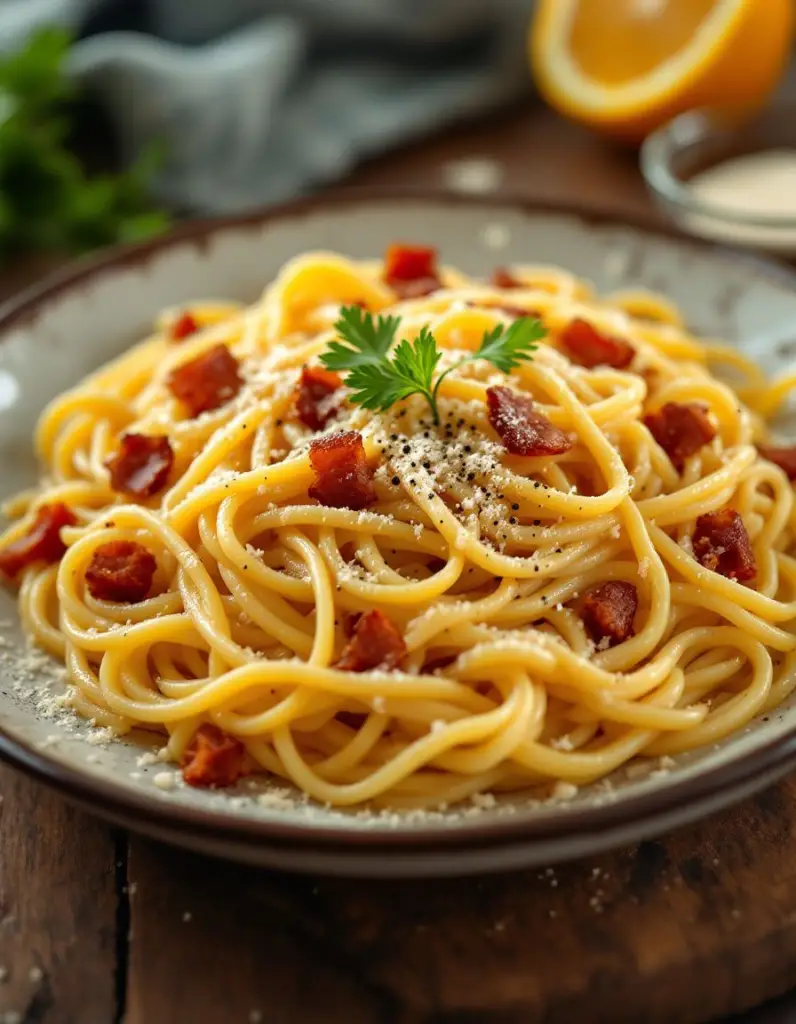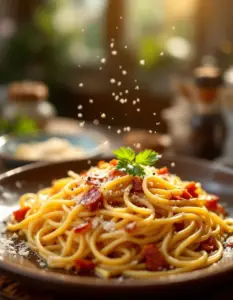Spaghetti Carbonara: A Classic Italian Delight
Indulge in the delightful flavors of traditional Italian cuisine with our Spaghetti Carbonara recipe. This classic pasta dish is known for its creamy texture and robust flavor profile, making it a beloved favorite across the globe. The harmonious blend of crispy pancetta, rich eggs, and aged Pecorino Romano cheese creates a velvety sauce that coats the spaghetti perfectly.
Not only is Spaghetti Carbonara quick and easy to make, but it also requires minimal ingredients, commonly found in most kitchens. With its comforting embrace and mouthwatering aroma, this dish is perfect for a weekday dinner or a special occasion. Once you try this recipe, you’ll understand why it remains a timeless staple in households worldwide.
Quick Recipe Highlights
- Flavor Profile: The salty pancetta balances beautifully with the creamy egg mixture, creating a savory richness that is utterly irresistible.
- Texture: The spaghetti offers a delightful al dente bite, while the sauce provides a silky texture that envelopes each strand.
- Aroma: Aromatic garlic and rendered fat from the pancetta form an enticing aroma that fills the kitchen, drawing everyone to the table.
- Visual Appeal: A generous showering of black pepper and bright cheese gives the dish an inviting and appetizing appearance.
- Skill Level Needed: This recipe is beginner-friendly, requiring only basic cooking techniques, making it accessible for all.
- Special Equipment: All you need is a pot for pasta, a frying pan, and a mixing bowl. No fancy gadgets required!
Recipe Overview
- Difficulty Level: Spaghetti Carbonara is relatively easy to prepare and does not demand advanced culinary skills. The key is to balance the temperature when mixing the sauce with the pasta.
- Category: This dish falls under the pasta category, perfect for either lunch or dinner, and shines as a weeknight meal.
- Cuisine: Originating from Rome, this recipe reflects the heart of Italian culinary tradition with its simple approach and quality ingredients.
- Cost: The ingredients are typically affordable, making it a budget-friendly meal option while still being impressive.
- Season: Spaghetti Carbonara is a year-round favorite, ideal for any season due to its hearty nature.
- Occasion: Great for casual family dinners, romantic nights in, or whenever you crave a hearty pasta dish.
Why You’ll Love This Recipe
The taste and texture of Spaghetti Carbonara are simply irresistible. The combination of crispy pancetta delivers a delightful crunch that contrasts beautifully with the creamy egg sauce. Each bite provides a rich umami flavor that is deeply satisfying, making it an ideal comfort food.
Convenience is another reason to adore this recipe. It comes together in just 30 minutes, making it perfect for busy weeknights when you still want a gourmet experience at home. The straightforward process ensures that even novice cooks can shine in the kitchen.
Nutritionally, Spaghetti Carbonara offers a good balance of carbohydrates and protein, especially when made with high-quality ingredients. The eggs provide essential vitamins while the cheese adds calcium, making this dish as nutritious as it is delicious.
Socially, whipping up a large pot of Spaghetti Carbonara creates an inviting atmosphere for gatherings. It’s a fantastic dish to share with friends and family, sparking conversations and creating lasting memories over hearty bites of pasta.
Considering its cost-effectiveness, this recipe uses affordable ingredients that yield generous servings, making it an economical choice for feeding a crowd without breaking the bank. You can indulge in the richness of a restaurant-style meal right at home.
Historical Background and Cultural Significance
Spaghetti Carbonara has an intriguing origin story that many food historians debate. Popular belief attributes the creation of this dish to Italian coal miners, who needed a hearty meal that could be prepared quickly. The dish symbolizes both simplicity and indulgence, marrying basic pantry items with rich flavors.
The cultural importance of Carbonara in Italian society cannot be overstated. It’s a testament to the tradition of using minimal ingredients to create robust flavors. This dish connects generations of Italian families, often served during gatherings and Sunday dinners, reinforcing family bonds through shared meals.
Over the years, the recipe has evolved from its rustic beginnings into a gourmet delicacy featured on menus worldwide. Each chef brings their unique flair to the dish, resulting in various interpretations while still honoring the classic elements that make Carbonara so beloved.
Regional variations of Carbonara also exist, featuring different types of pasta or incorporating local ingredients. These adaptations showcase Italy’s diverse culinary landscape while staying true to the dish’s essence.
Ingredient Deep Dive
Pasta: Traditionally, spaghetti is used in Carbonara, serving as the perfect vehicle for the sauce. When selecting pasta, look for high-quality dried varieties. Whole grain options can add additional nutrients, while gluten-free pasta is available for those with dietary restrictions. Store pasta in a cool, dry place, and it can last for years.
Pancetta: This Italian cured meat adds essential flavor to the dish. Choose pancetta that is well-marbled for a rich taste. If unavailable, bacon can be a substitute, offering a smoky element. Store uncooked pancetta in the refrigerator and use it within a week once opened.
Eggs: The heart of the Carbonara sauce, eggs provide creaminess and flavor. Use fresh, organic eggs for the best results, as they contribute to the dish’s richness. Store eggs in the refrigerator and be cautious of using very old eggs for this recipe.
Pecorino Romano: This robust cheese is essential for authentic Carbonara. It enhances the dish with its saltiness and flavor. When selecting cheese, opt for freshly grated varieties for the best results. Store cheese in the refrigerator, wrapped properly to maintain freshness.
Common Mistakes to Avoid
- Using pre-grated cheese: It lacks the fresh flavor and texture needed for a true Carbonara.
- Cooking the eggs too long: Adding them to hot pasta is key; otherwise, you risk scrambling them.
- Overcooking the pasta: Always cook to al dente for the best texture.
- Not reserving pasta water: This starchy water is crucial for achieving the desired sauce consistency.
- Skipping the black pepper: Freshly cracked pepper adds needed spice and flavor depth.
- Using cold ingredients: Everything should be warm when you combine them to ensure the right sauce consistency.
- Rushing the cooking process: Allow the pancetta to crisp up without slacking off for maximum flavor.
- Not tasting: Always taste and adjust seasoning before serving for the best flavor.
Essential Techniques
Creating a Creamy Sauce: The key to the creamy Carbonara sauce lies in tempering the eggs with warm pasta. This is crucial to avoid scrambling. Remember to combine everything off the heat to ensure a smooth texture.
Cooking Pasta Properly: Mastering pasta cooking allows for the ideal texture in your Carbonara. Following package instructions for al dente is essential; remember to reserve some pasta water for the sauce.
Pro Tips for Perfect Spaghetti Carbonara
1. Use the freshest ingredients possible for the best flavor. Fresh eggs, high-quality cheese, and artisanal pasta are worth the investment.
2. Balance flavors by tasting the sauce before serving. Adjust seasoning as needed, especially with the cheese, which can be quite salty.
3. Save your pasta water! Adding a splash can enhance the sauce’s creaminess and help it adhere to the pasta.
4. Embrace the pepper. Freshly cracked black pepper not only adds heat but also complements the creamy sauce beautifully.
5. Consider a finishing touch of extra cheese just before serving for added richness.
6. Serve immediately after tossing to prevent the sauce from thickening too much, keeping it creamy and luscious.
7. Don’t be afraid to experiment with different types of pork, such as guanciale, for an authentic Italian experience.
Variations and Adaptations
For a regional variation, try using rigatoni instead of spaghetti for a different texture; it holds the sauce well. Moreover, you can adapt the recipe for seasonal variations by incorporating vegetables such as peas or asparagus for added freshness.
If you’re looking for dietary adjustments, consider gluten-free pasta options, or for a lower-calorie version, substitute whole eggs with egg whites. For those on a dairy-free diet, vegan cheese could work as a replacement for Pecorino Romano.
In terms of flavor, adding garlic or crushed red pepper can spice up your dish, while nutmeg can provide additional warmth to the sauce.
Presentation can also be varied; consider serving in individual bowls or using fresh herbs as a garnish for a touch of freshness.
Serving and Presentation Guide
Plating your Spaghetti Carbonara can enhance the dining experience significantly. Twirl the pasta onto a fork and lift it gently onto your plate, creating height and visual appeal. Garnish with a sprinkle of fresh parsley or a few shavings of cheese on top for color.
For traditional accompaniments, a simple green salad and crusty bread can help balance the richness of the Carbonara. Modern serving suggestions might include serving alongside a glass of Pinot Grigio.
Ensure the dish is served hot immediately after preparation, retaining the sauce’s luscious creaminess. Portion control can also be considered; a typical serving is about one cup of pasta, making it easy to moderate servings.
Wine and Beverage Pairing
For an ideal wine pairing, a crisp white, such as Pinot Grigio or Chardonnay, works beautifully as it complements the richness of the Carbonara. The acidity in these wines refreshes the palate, balancing the creamy texture.
If you prefer non-alcoholic beverages, consider pairing with sparkling water infused with citrus, which can cleanse the palate without overpowering the dish. If you enjoy tea or coffee, a light herbal tea would work well.
Serving temperature is also key; chilled white wine enhances the overall experience when dining on this rich pasta dish.
Storage and Shelf Life
For proper storage, leftovers can be kept in an airtight container in the refrigerator for up to 3 days. Be mindful that the pasta may absorb the sauce, thickening it significantly.
When reheating, add a splash of reserved pasta water or cream to restore its original texture. Avoid freezing the dish, as dairy-based sauces do not hold up well to freezing and may separate when thawed.
Signs of spoilage include an off smell or discoloration. Always reheat to a safe internal temperature before consuming.
Make Ahead Strategies
While Spaghetti Carbonara is best enjoyed freshly made, you can prep some elements ahead. Cook the pasta and pancetta in advance, storing them separately in the fridge. Prepare your cheese and eggs mixture to speed up last-minute preparations.
When ready to serve, reheat the pancetta and combine with hot pasta. Then, temper the eggs and mix everything off the heat for a quick finish!
Scaling Instructions
To halve the recipe, simply divide the quantities by two, adjusting timing as needed. Scaling up is possible, too; just ensure you have a large enough pot to accommodate additional pasta while maintaining even cooking.
For larger groups, consider using a big pot or two, and always taste as you adjust seasoning. Remember to keep cooking time in check as larger amounts might require more cooking, but overall, the method remains the same.
Nutritional Deep Dive
Each serving of Spaghetti Carbonara typically contains a balanced macronutrient profile, comprising carbohydrates from the pasta, protein from the eggs and pancetta, and fat from the cheese. This balance makes it a wholesome meal when enjoyed in moderation.
Micronutrient analysis indicates a healthy dose of calcium from cheese, B vitamins from pasta, and essential amino acids from eggs. For those monitoring calories or following specific diets, consider adjusting portion sizes to maintain caloric balance without sacrificing satisfaction.
Dietary Adaptations
For gluten-free adaptations, choose suitable pasta alternatives, such as rice or chickpea pasta, ensuring the same delicious flavor and texture without the gluten. Dairy-free requires using plant-based cheeses and nutritional yeast for a similar flavor.
Vegans can recreate this dish by using tofu for protein and cashew cream as an egg replacement, allowing for a creamy sauce without the use of animal products.
For low-carb diets, zucchini noodles can be a fantastic substitute, giving that “pasta” experience with fewer carbs, while maintaining the Carbonara’s rich flavors.
Troubleshooting Guide
If your sauce turns out too thick, adding reserved pasta water helps achieve the right consistency. For a too-salty dish, incorporating a dash of cream can balance it out.
Texture issues such as overly crisp pancetta can be solved by cooking it at a lower temperature; this way, renders the fat while maintaining the right chewiness. If the pasta is undercooked, remember to add it to boiling water longer but keep a close eye to avoid overcooking.
For flavor balance, if the dish lacks depth, additional cheese or a touch of lemon juice can elevate the taste profile effectively; taste and adjust as necessary.
Recipe Success Stories
Community feedback for this Spaghetti Carbonara recipe has been overwhelmingly positive, with many enjoying its simplicity and elegance. Readers have reported back on their variations, with some incorporating sautéed mushrooms or spring peas for an added pop of color and flavor.
Photographers have shared beautiful images of their plates, showcasing the creamy texture and inviting presentation. Others have experimented with garnishes, creating stunning plates that look as good as they taste.
Frequently Asked Questions
While spaghetti is traditional, you can use other pasta varieties, such as fettuccine or penne. Just remember to adjust cooking times accordingly.
Is it safe to eat raw eggs in Carbonara?
Using fresh, high-quality eggs minimizes risks. For added safety, use pasteurized eggs that reduce the chance of foodborne illness.
How can I make my Carbonara vegetarian?
You can replace pancetta with mushrooms or smoked tofu, retaining that umami flavor without meat.
Can I prepare Carbonara ahead of time?
While best fresh, you can prep ingredients (like pasta and sauce) separately and combine just before serving to maintain the desired texture.
What can I serve with Carbonara?
A simple green salad and a glass of white wine complement the richness of Carbonara beautifully.
How do I ensure a creamy Carbonara?
Temper the eggs with the warm pasta and make sure to mix everything off the heat to create the sauce without scrambling eggs.
What’s the best cheese for Carbonara?
Pecorino Romano is traditional, but a mix with Parmigiano Reggiano can add depth and richness.
Can I freeze Carbonara?
It is not recommended to freeze Carbonara due to the creamy sauce’s tendency to separate upon thawing.
How spicy is Carbonara?
The spice level primarily depends on the amount of black pepper used; feel free to adjust to suit your taste!
Are there variations to Carbonara?
Absolutely! Regional adaptations include adding vegetables or using different types of cured meats.
Additional Resources
Explore related recipes such as Fettuccine Alfredo or Penne Arrabbiata for more pasta ideas. Learn essential techniques like making your own pasta or proper cheese grating skills for better results in your culinary adventures.
Check out ingredient information for details on selecting quality pasta and understanding the varieties of cheese available. Investing in the right kitchen equipment can also make a significant difference in your cooking experience, so consider recommendations tailored specifically for pasta dishes.
Join the Conversation
We love hearing from our readers! Share your experience with this Spaghetti Carbonara recipe on social media or leave your thoughts in the comments below. Share photos of your homemade dishes and connect with other food enthusiasts who appreciate the flavors of Italy.
Recipe reviews help us improve and refine our content. Tell us about any variations you’ve incorporated or tips that worked for you. Join our growing community of pasta lovers and celebrate the joy of cooking!
The Recipe
Spaghetti Carbonara
Serves: 4 servings
Prep Time: 10 mins
Cook Time: 20 mins
Total Time: 30 mins
Kitchen Equipment Needed
- Large pot for boiling pasta
- Frying pan or skillet
- Mixing bowl
- Colander
- Tong or serving fork
Ingredients
- 400g spaghetti
- 150g pancetta, diced
- 3 large eggs
- 100g Pecorino Romano cheese, grated
- Black pepper, freshly cracked
- Salt, to taste
Directions
- Boil salted water in a large pot and cook the spaghetti according to package instructions until al dente. Reserve 1 cup of pasta water before draining.
- In a frying pan, cook the pancetta over medium heat until crispy, then remove from heat.
- In a mixing bowl, whisk together the eggs and Pecorino Romano cheese until smooth. Add a generous amount of black pepper.
- Add hot pasta to the pan with pancetta and toss to combine. Remove from heat.
- Quickly pour the egg mixture over the pasta, mixing vigorously to create a creamy sauce. Add reserved pasta water a little at a time to achieve desired consistency.
- Test seasoning and serve immediately with extra cheese and pepper on top.
Recipe Notes
- For added flavor, consider adding garlic when cooking the pancetta.
- Substitutions can be made with bacon or guanciale if needed.
- Try adding peas or asparagus for a seasonal twist.










